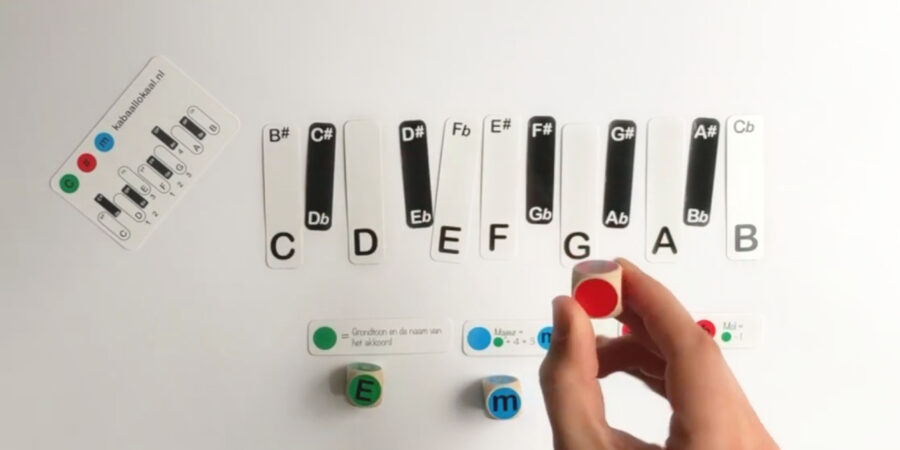
3 + 4 = 7 is a game developed by Thijs Spook using the MDA-model and teaches students how to translate a chord symbol to the piano or keyboard. In a playful and simple way, everyone can quickly learn how to play any chord, like a D# minor chord for example. All chords in major and minor, with sharps and flats, come can be covered with this game, as well as inversions. With this game pupils will be able to learn independently how to play a song song from just a simple chord scheme, just by playing this game and looking up the chords. It’s all about practicing a simple formula to create any major, or minor chord. As you can see the piano is ‘cut up’ into seperate keys and the assignments (i.e. which chords to build) are made by throwing dice. These are the basic mechanics used.
What Thijs wanted to create with this game is the feeling of ease and success by the student when they realise that recognizing a chord symbol and playing that on a piano is not something to be uncertain or even afraid about. Anybody can play any chord as long as you can count to four. The MDA-model of this game looks something like this.

With the help of the cheat sheets, the dice and the piano keys, the students can form any major or minor chord that is thrown by the dice. And what you see is students counting, trying, and – what I didn’t plan for, but what’s really nice – they start checking each other. So, feedback on how they are doing is automatically in the game. That was a lucky shot.
Last year I played this game with second graders (13 years old). When everybody was started up, I left the classroom for about 15 minutes. When I came back, no one even noticed I had left, not even my intern, who was also playing.
Thijs Spook
Watch the video to see how the game is used.
To add a little tension and more excitement to the game, poker chips were added as a reward for every good chord. This is experienced as a ‘collecting-mechanic’ by the player: they love collecting poker chips, even if it has no further value during the game. Thijs also added a timer, so the pace of the game is maintained. The most important part of the ‘timer-mechanic’ is keeping their attention to the game. It’s easy to have your mind wander off if other students are proceeding very slowly. The timer prevents that and keeps everyone ‘on the edge of their seat’.
Gamebox contents
6 pianos: the 12 different keys in 12 different cards
3 cheat cards
3 dice
Game manual
The game is intellectual property of Kabaallokaal and can be obtained through their webshop.





